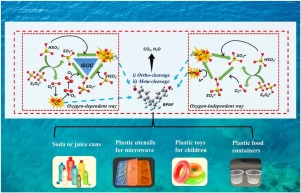当前位置:
X-MOL 学术
›
J. Hazard. Mater.
›
论文详情
Our official English website, www.x-mol.net, welcomes your
feedback! (Note: you will need to create a separate account there.)
Crucial roles of oxygen and superoxide radical in bisulfite-activated persulfate oxidation of bisphenol AF: Mechanisms, kinetics and DFT studies.
Journal of Hazardous Materials ( IF 12.2 ) Pub Date : 2020-02-04 , DOI: 10.1016/j.jhazmat.2020.122228 Jingquan Wang 1 , Chengjin Wang 2 , Hongguang Guo 1 , Tao Ye 3 , Yang Liu 1 , Xin Cheng 4 , Wei Li 1 , Bo Yang 1 , Erdeng Du 5
Journal of Hazardous Materials ( IF 12.2 ) Pub Date : 2020-02-04 , DOI: 10.1016/j.jhazmat.2020.122228 Jingquan Wang 1 , Chengjin Wang 2 , Hongguang Guo 1 , Tao Ye 3 , Yang Liu 1 , Xin Cheng 4 , Wei Li 1 , Bo Yang 1 , Erdeng Du 5
Affiliation

|
Though natural reducing agents have been demonstrated as desirable catalysts for environmental remediation, the mechanism of catalytic activation of persulfate (PS) by bisulfite (S(IV)) remains unclear. In this study, an emerging contaminant bisphenol AF (BPAF) was employed as the target compound to examine the activation and degradation mechanism in PS/S(IV) system. Sulfate radical (SO4•-) was evidenced as the dominant radical accounting for BPAF degradation via quantitative analysis, while hydroxyl radical (•OH) and singlet oxygen (1O2) were minor contributors. Superoxide radical (O2•-) was identified as an intermediate radical in promoting BPAF removal through quenching experiments and electron paramagnetic resonance analysis. Tests in oxygen-rich and oxygen-deficient systems were conducted and the results were contrasted to elucidate the important role of oxygen in BPAF degradation and SO4•--formation. In addition, the effect of Dissolved Oxygen (DO) was simulated using two separate kinetic models. Decomposition mechanism of BPAF was afterwards clarified via the density-functional theory calculations using Fukui index to predict the vulnerable sites and the intermediate products. This study provides a mechanistic understanding of the activation of PS/S(IV) system on the BPAF removal, especially the critical role of DO and O2•- in SO4•- generation.
中文翻译:

氧和超氧自由基在双酚AF的亚硫酸氢盐活化过硫酸盐氧化中的关键作用:机理,动力学和DFT研究。
尽管已证明天然还原剂是用于环境修复的理想催化剂,但亚硫酸氢盐(S(IV))催化过硫酸盐(PS)的活化机理仍不清楚。在这项研究中,新兴的污染物双酚AF(BPAF)被用作目标化合物,以检查PS / S(IV)系统中的活化和降解机理。定量分析表明,硫酸根(SO4•-)是造成BPAF降解的主要自由基,而羟基(•OH)和单线态氧(1O2)的贡献较小。通过淬灭实验和电子顺磁共振分析,超氧自由基(O2•-)被认为是促进BPAF去除的中间自由基。在富氧和缺氧系统中进行了测试,并与结果进行了对比,以阐明氧气在BPAF降解和SO4•-形成中的重要作用。此外,使用两个独立的动力学模型模拟了溶解氧(DO)的作用。之后,通过使用Fukui指数的密度泛函理论计算来预测易损部位和中间产物,从而阐明了BPAF的分解机理。这项研究提供了对PS / S(IV)系统在BPAF去除上的活化的机械理解,尤其是DO和O2•-在SO4•-生成中的关键作用。之后,通过使用Fukui指数的密度泛函理论计算来预测易损部位和中间产物,从而阐明了BPAF的分解机理。这项研究提供了对PS / S(IV)系统在BPAF去除上的活化的机械理解,尤其是DO和O2•-在SO4•-生成中的关键作用。之后,通过使用Fukui指数的密度泛函理论计算来预测易损部位和中间产物,从而阐明了BPAF的分解机理。这项研究提供了对PS / S(IV)系统在BPAF去除上的活化的机械理解,尤其是DO和O2•-在SO4•-生成中的关键作用。
更新日期:2020-02-04
中文翻译:

氧和超氧自由基在双酚AF的亚硫酸氢盐活化过硫酸盐氧化中的关键作用:机理,动力学和DFT研究。
尽管已证明天然还原剂是用于环境修复的理想催化剂,但亚硫酸氢盐(S(IV))催化过硫酸盐(PS)的活化机理仍不清楚。在这项研究中,新兴的污染物双酚AF(BPAF)被用作目标化合物,以检查PS / S(IV)系统中的活化和降解机理。定量分析表明,硫酸根(SO4•-)是造成BPAF降解的主要自由基,而羟基(•OH)和单线态氧(1O2)的贡献较小。通过淬灭实验和电子顺磁共振分析,超氧自由基(O2•-)被认为是促进BPAF去除的中间自由基。在富氧和缺氧系统中进行了测试,并与结果进行了对比,以阐明氧气在BPAF降解和SO4•-形成中的重要作用。此外,使用两个独立的动力学模型模拟了溶解氧(DO)的作用。之后,通过使用Fukui指数的密度泛函理论计算来预测易损部位和中间产物,从而阐明了BPAF的分解机理。这项研究提供了对PS / S(IV)系统在BPAF去除上的活化的机械理解,尤其是DO和O2•-在SO4•-生成中的关键作用。之后,通过使用Fukui指数的密度泛函理论计算来预测易损部位和中间产物,从而阐明了BPAF的分解机理。这项研究提供了对PS / S(IV)系统在BPAF去除上的活化的机械理解,尤其是DO和O2•-在SO4•-生成中的关键作用。之后,通过使用Fukui指数的密度泛函理论计算来预测易损部位和中间产物,从而阐明了BPAF的分解机理。这项研究提供了对PS / S(IV)系统在BPAF去除上的活化的机械理解,尤其是DO和O2•-在SO4•-生成中的关键作用。

































 京公网安备 11010802027423号
京公网安备 11010802027423号